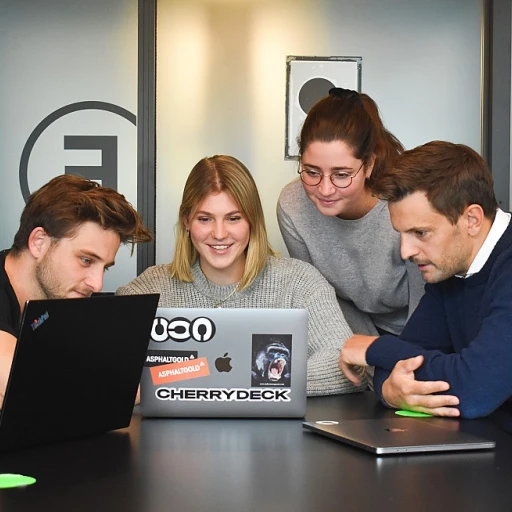
Understanding Co-Development Software
Exploring the Potential of Co-Development Solutions
In the dynamic landscape of software development, businesses are increasingly turning towards co-development software as an innovative approach to enhance collaboration across multiple teams. This powerful model breaks away from traditional software development approaches, promoting a shared ownership mindset among team members, and fostering an environment of collaborative innovation.
Co-development software acts as a bridge between diverse development teams, enabling them to work on projects in real time with effective communication tools and a streamlined development process. This is especially beneficial for industries that thrive on constant feedback and rely heavily on version control and quality assurance in their development lifecycle.
Rather than isolated silos, co-development encourages a more integrated approach where expertise from different areas comes together to innovate and produce high-quality solutions. This method not only enhances communication among team members but also improves project management through transparent decision-making processes.
The growing interest in this model reflects its potential to transform how development projects are executed. For New Zealand companies in particular, leveraging co-development software can lead to more efficient operations and a competitive edge in their respective markets. These businesses can benefit from the productivity gains and collaborative advantages offered by modern online collaborative productivity tools that enhance communication and project execution.
Benefits for New Zealand Companies
The Value Proposition for Kiwi Enterprises
New Zealand companies have witnessed a significant transformation in how teams collaborate on software development projects. The integration of co-development software into the project management lifecycle offers an enhanced collaborative platform that is especially beneficial for businesses looking to harness innovation and expertise across various industries.- Improved Quality and Efficiency: These tools enable real-time communication and feedback, allowing teams to refine their approaches and solutions quickly. This translates into higher quality deliverables within shorter timeframes.
- Fostering Innovation: By bringing together multiple teams, each with its own set of skills and perspectives, co-development software fosters an environment ripe for innovative solutions. The shared ownership and collaborative approach stir creativity and push the boundaries of traditional development models.
- Flexibility and Scalability: With the right tools, businesses can efficiently scale their projects up or down based on demand. This adaptability is crucial for responding to market changes and embracing new opportunities without overburdening resources.
- Streamlined Communication: The centralization of communication tools ensures that all team members remain up-to-date with the project’s progress. This reduces the risk of miscommunication and enhances the decision-making process.
- Shared Expertise Across Borders: Co-development software bridges the geographic gap, allowing team members from different locations to collaborate seamlessly. As a result, New Zealand enterprises can tap into global expertise without the need for physical relocations.
Challenges in Implementation
Overcoming Obstacles in Implementing Collaborative Tools
Implementing co-development software comes with its own unique set of challenges that businesses in New Zealand need to address to fully benefit from its capabilities. While the collaborative approach can lead to significant gains in innovation and productivity, several hurdles might prevent teams from realizing its full potential. Firstly, aligning multiple teams under a shared development model can be complex. Differences in work practices across various teams, especially those spanning different industries, may hinder seamless collaboration. Ensuring that each team member is on the same page requires effective communication tools and project management strategies that facilitate real-time updates and feedback. Without these, teams may find themselves struggling with miscommunications and delays in their development projects. Another challenge lies in the learning curve associated with new development tools. Transitioning from traditional software practices to a more collaborative development lifecycle can be daunting for team members who might be resistant to change. It is essential for businesses to provide training and support to ease this transition and encourage adaptability among their teams. In addition, managing version control in a collaborative setting is notoriously tricky. With multiple teams contributing to the project, maintaining quality and avoiding conflicting changes demand robust version control systems. This requires careful planning and decision making from the outset to ensure that the development software aligns with the project goals. Furthermore, the shared ownership that co-development promotes can sometimes lead to unclear lines of authority and accountability. Establishing clear roles and responsibilities within the team is vital to maintaining the quality and timeliness of development projects. Despite these challenges, New Zealand businesses can still achieve significant gains by adopting co-development software. With a strategic approach and the right set of communication and development tools, companies can overcome these barriers to enhance their project outcomes. For more insight into how New Zealand companies are tackling similar challenges and celebrating milestones, visit this article that delves into real-world applications and successes.Case Studies from New Zealand
Real-World Implementations and Insights
In New Zealand, various industries have successfully leveraged co-development software to enhance project outcomes and foster collaborative environments. These case studies offer valuable insights into practical applications and the impact of co-development on businesses. One notable example is the technology sector, where multiple teams worked together on cutting-edge software projects. These teams utilized advanced communication tools and shared ownership models to maintain high-quality outputs and efficient decision-making processes. By fostering an environment of continuous feedback, they improved real-time project management and streamlined the development lifecycle. The manufacturing industry, too, has seen significant improvements through the adoption of co-development software. By integrating development tools that promote version control and innovation, manufacturing companies have optimized their product development processes. This approach not only minimized production errors but also enhanced time efficiency, ultimately reducing costs. Healthcare organizations in New Zealand have similarly benefited from collaborative development strategies. Through co-development, various healthcare entities have pooled their expertise to create innovative solutions that address both medical and administrative challenges. This collaborative approach has encouraged better communication and integration of multiple expertise, improving healthcare project outcomes. These successes indicate the profound transformational potential of co-development software across different industries. New Zealand companies, by adopting these collaborative models, can continue to innovate and maintain a competitive edge in their respective fields.Choosing the Right Software
Identifying the Best Fit for Your Business Needs
Choosing the right co-development software for your company is a crucial step that directly influences the success of your collaborative projects. To simplify this process, start by evaluating your unique business requirements and understanding how different software solutions can address these demands.- Assess the Collaboration Needs: Determine whether your projects involve multiple teams or rely heavily on real-time communication and decision making. The right software should facilitate seamless collaboration, enabling team members to work together efficiently.
- Evaluate the Tool's Compatibility: Ensure that the software aligns with your existing development process and tools. This includes checking for compatibility with your current project management systems and version control practices, which reduces disruption to your team's workflow.
- Focus on Industry Expertise: Consider software solutions that demonstrate specialized expertise in your industry. This can enhance the quality of project outcomes by integrating tailored features that are specific to your field.
- Prioritize Communication Tools: Effective communication lies at the heart of successful collaboration. Look for software that integrates robust communication features to support continuous feedback and shared ownership within development teams.
- Analyze Case Studies: Consult case studies from other New Zealand businesses that have successfully implemented co-development software. This can provide valuable insights into potential challenges and innovative solutions that have worked in similar contexts.
- Anticipate Future Growth: Lastly, select a solution that is scalable and can adapt to your company’s growth and changing needs. A flexible software development model ensures sustained collaboration and innovation as your team expands.
Future Trends in Co-Development
Anticipating Future Developments in Co-Development Software
As New Zealand companies continue to embrace co-development software, understanding future trends is crucial for staying competitive. The landscape of software development is rapidly evolving, with several key trends shaping the future of collaborative work.
Firstly, the integration of artificial intelligence (AI) and machine learning into development tools is set to revolutionize how teams approach projects. AI can enhance project management by predicting potential roadblocks and suggesting innovative solutions, thereby improving the overall quality and efficiency of development projects.
Another significant trend is the increasing importance of real-time communication tools. As teams become more distributed, seamless communication becomes vital. Tools that offer instant feedback and facilitate decision-making processes will be indispensable for maintaining productivity and ensuring that all team members are aligned.
Moreover, the concept of shared ownership in software projects is gaining traction. This approach encourages multiple teams to collaborate closely, fostering a sense of collective responsibility and enhancing the development lifecycle. By leveraging the diverse expertise of team members, businesses can drive innovation and deliver superior software solutions.
Finally, the adoption of cloud-based development environments is expected to grow. These environments offer flexibility and scalability, allowing teams to work on projects from anywhere in the world. This shift not only supports remote work but also facilitates the integration of diverse industries and expertise into the development process.
In conclusion, staying abreast of these trends will be essential for New Zealand companies looking to optimize their co-development strategies. By embracing these advancements, businesses can enhance collaboration, streamline their development model, and ultimately deliver high-quality software solutions.











